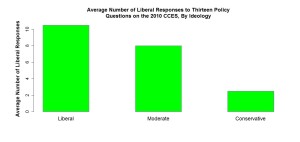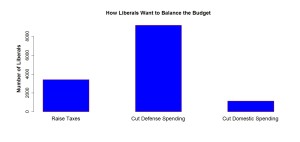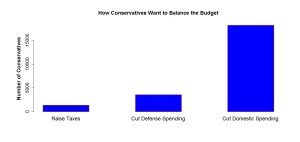Recently, The Washington Post’s Monkey Cage blog discussed the idea of “symbolic ideology.” Some social scientists and political commentators believe that ideology in the American public is not very meaningful. While acknowledging that a majority of Americans identify as liberal or conservative, these observers point out that many people have issue positions that conflict with their chosen ideology. If you analyze Americans’ actual preferences on potential government policies, they say, instead of whether they simply identify as liberal or conservative, you find that their chosen ideology does not match their beliefs about specific issues. They believe that ideology for many Americans is merely symbolic. It reflects their personality or view of the world or something they want to identify with, but is not related to the policies that they sincerely want government to pursue.
The idea of symbolic ideology has drawn a lot of attention. It is certainly a counterintuitive argument, and anything that challenges conventional wisdom dramatically tends to get people engaged. This strain of thought basically argues that a large part of the American public is confused or ignorant about what it wants. If it is correct, our understanding of what citizens desire from the government is inherently flawed. Liberal and conservative politicians would then be spending a lot of time trying to represent people who nominally agree with them, but in reality want something completely different! Additionally, the symbolic ideology argument has gotten a lot of press because it is comforting to liberals and conservatives who have trouble understanding the other side. If one has difficulty comprehending why someone else would generally take the opposite view of government policies, the idea that many people are confused is intuitively appealing.
Even if it is appealing to some, the idea of symbolic ideology is wrong. Americans who say they are conservative have pretty conservative views on a wide range of policies, and Americans who say they are liberal have pretty liberal views on a wide range of policies. Self-identified moderates are somewhere in between.
To see that self-identified liberals are actually liberal and self-identified conservatives are actually conservative, I analyzed data from the 2010 Cooperative Congressional Election Study (CCES). I chose thirteen policy-related questions with clear liberal and conservative answers, and examined how tens of thousands of Americans who participated in the 2010 CCES responded.
The chosen questions included whether there should be more or less gun control, whether global warming is a serious problem that requires action, when abortion should be legal, whether protecting the environment is more important than protecting jobs, whether there should be a Constitutional Amendment banning gay marriage, whether the respondent supports or opposes affirmative action, how the federal budget should be balanced, if the respondent supports or opposes the $787 billion in federal stimulus spending, if the respondent supports or opposes federal insurance for children in low-income households (SCHIP), whether the respondent supports a cap-and-trade law for carbon emissions, if the respondent supports or opposes a bill that requires Americans to have health insurance and increases taxes on those making more than $280,000 a year while setting up a health insurance option for those without coverage, whether the respondent supports a bill that would allow gays to serve openly in the military, and if the respondent supports or opposes a bill that allows federal funding of embryonic stem cell research.
These questions cover a large range of economic and social policies. They include many politically salient issues, including healthcare, gay marriage, abortion, taxes, global warming, and budgets and spending. Furthermore, answers to these questions are related to each other. People who respond liberally on one are more likely to respond liberally on others. One might guess that this is because the issues asked about in these questions have a lot to do with conservative or liberal ideology. This is true, and contradicts the claims of those who view ideology in the public as relatively meaningless.
The chart below shows how Americans who identify as liberal (either “liberal” or “very liberal”), moderate, or conservative (either “conservative” or “very conservative”) responded to these thirteen policy questions. The plot shows the average number of conservative answers given to these questions by members of each ideological group. Liberals give an average of about 1.5 conservative answers to the thirteen questions, moderates give an average of about 3.5 conservative answers, and conservatives give an average of about 9 conservative answers. Clearly, self-identified ideology is strongly related to holding conservative views on different policy issues.
Ideology is also strongly related to holding liberal views on those same policy issues. The chart below shows how many liberal responses that liberals, moderates, and conservatives give to those same questions. Liberals give an average of about 10.5 liberal responses to the thirteen questions, moderates give an average of 8 liberal responses, and conservatives give an average of 2.5 liberal responses. Again, the liberals are liberal, the conservatives are conservative, and the moderates are somewhere in the middle. The ideologies that Americans identify with are not vague concepts, but meaningful labels that indicate particular kinds of policy views.
Analyzing the issue of government budgets and spending highlights the importance of ideology for Americans’ views on policies. The 2010 CCES asks respondents the following question: “The federal budget is approximately $600 billion this year. If the Congress were to balance the budget it would have to consider cutting defense spending, cutting domestic spending (such as Medicare or Social Security), or raising taxes to cover the deficit. What would you most prefer that Congress do – cut domestic spending, cut defense spending, or raise taxes?”
Americans’ answers to this question vary with their ideology, and demonstrate one reason that it is difficult to find compromise in politics. Conservatives and liberals genuinely want the government to do different things. The charts below display how self-identified liberals, moderates, and conservatives from the 2010 CCES want to balance the budget.
The results are what one might expect. Most liberals want to balance the budget by cutting defense, with a sizable group that wants to balance it by raising taxes. Only a small percentage of liberals want to balance the budget by cutting domestic spending. About half of moderates want to balance the budget by cutting defense, with the other half split between raising taxes and cutting domestic spending.
It is pretty clear what conservatives want. In line with their ideology, conservatives overwhelmingly want to balance the budget by cutting domestic spending. Therefore, one reason that conservatives and liberals have a hard time agreeing how to balance the federal budget is that conservatives strongly prefer to balance it by cutting domestic spending, while liberals strongly prefer not to balance it that way.
Ideology is meaningful for many Americans. Identifying as “liberal” or “conservative” is strongly related to liberal and conservative policy preferences. Even though they might have a few positions that don’t fit with their overall ideology, conservatives and liberals generally have conservative and liberal beliefs about a wide range of salient issues. When asked to make difficult choices about policy options to balance the budget, liberals and conservatives choose very differently. Those conservatives are actually conservative, and those liberals are actually liberal.





